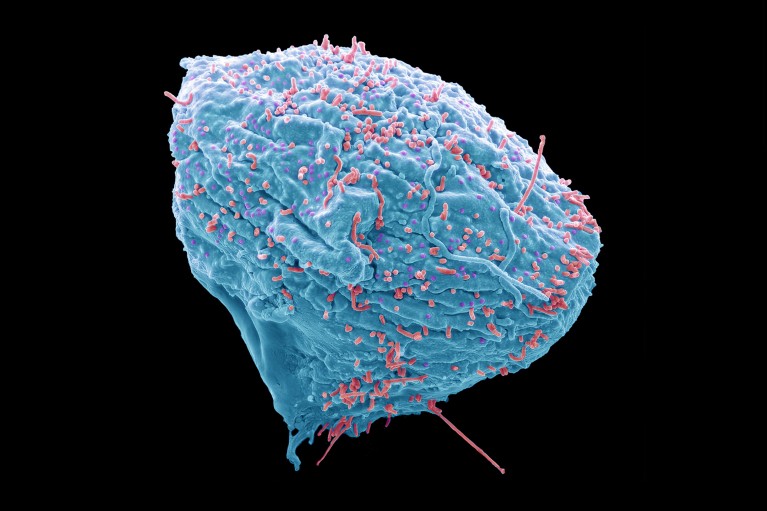
Particles of avian influenza (pink) infect a human cell (blue). Early evidence suggests that the virus infecting a person in Canada could have some worrisome mutations. Credit: Steve Gschmeissner/Science Photo Library
In a children’s hospital in Vancouver, Canada, a teenager is in critical condition after being infected with an avian influenza virus that has researchers on high alert.
Viral genome sequences released last week suggest that the teenager is infected with an H5N1 avian influenza virus bearing mutations that might improve its ability to infect the human airway. If true, it could mean that the virus can rapidly evolve to make the jump from birds to humans.
It’s a worrying development but it doesn’t mean that a new pandemic is imminent, says immunologist Scott Hensley at the University of Pennsylvania in Philadelphia. At present, there is no sign that the virus — which is related but not identical to the H5N1 virus infecting US dairy cattle — has been transmitted from the sick adolescent to other people.
“There is reason to be concerned,” he says. “But not reason to totally freak out.”
How did the teenager get infected?
That is unclear. The adolescent did not work or live on a poultry farm, and researchers have found no signs of H5N1 infection in household pets, said Bonnie Henry, a public health officer for the province of British Columbia in Victoria, Canada, during a press conference. “There is a very real possibility that we may not ever determine the source,” Henry said.
Why is this virus so concerning?
The sequencing data suggest that the teenager is infected with a mixture of viruses, all of which are similar to a lineage of H5N1 viruses that is currently infecting poultry and waterfowl in the region. But researchers have homed in on three key differences between those viruses and the teenager’s: two possible mutations that could enhance the virus’s ability to infect human cells, and another that could allow it to replicate more easily in human cells, not just in the cells of its usual avian host.
Could bird flu in cows lead to a human outbreak? Slow response worries scientists
One interpretation of the sequencing data is that some of the viruses infecting the teenager contain the new mutations, and some do not. Such a result could also indicate an error in the sequencing process, but the rest of the sequences look clean and this particular constellation of mutations is unlikely to occur by chance, says Jesse Bloom, who studies viral evolution at the Fred Hutchinson Cancer Center in Seattle, Washington. “It pops out,” he says. “It suggests that there is some evolution going on in this virus right at these important positions.”
Furthermore, the teenager initially had an eye infection, which later developed into a severe lung infection. This could suggest that the virus became better able to enter airway cells after it had infected the adolescent. “It’s consistent with the idea that the virus might have evolved within that individual,” says Hensley.
That could be good news of a sort: it implies that the mutated form of the virus was not the form that originally infected the teenager, and therefore that it might not be circulating widely.
Are we on the cusp of another pandemic?
Public-health authorities in Canada have tested about three-dozen close contacts of the infected teenager, none of whom seem to have had H5N1 infections. “It doesn’t appear that there is any indication that this individual transmitted this virus on to others,” says Bloom.
And just because a virus has evolved to better infect and replicate in human cells, that does not mean that it has also gained the ability to spread to other people, says Hensley. “Being able to bind to human cell is a prerequisite to cause a pandemic,” he says. “But it’s often not sufficient.”
Even so, governments and researchers have been preparing in case H5N1 does become transmissible between people. Scientists are developing and testing vaccines against the currently circulating H5N1 viruses, and research1 has shown that stockpiles of H5N1 vaccines designed in the mid-2000s might still be effective against more recent H5N1 viruses. Hensley says that these vaccines are also likely to be effective against viruses such as those found in the teenager.
“It’s not the time to panic,” he says. “But this should serve as a warning: this virus has the capacity to switch very quickly into a form that can cause severe disease.”
What do we know about H5N1 infections in people?
There have been 53 confirmed H5N1 infections in humans in the United States this year. Most of these have been linked to a viral strain that can infect cattle and has swept through dairy herds around the country — and has also caused illness in some of the farm workers who tend the animals.
Flu causes huge spike in child hospitalizations in Canada
Public-health officials are concerned that these viruses might become more adept at infecting human hosts, especially during the human flu season. This could give H5N1 viruses the opportunity to swap genetic material with human flu strains, picking up the ability to infect humans and transmit between people, Henry said. For now, however, such infections have typically been mild, often causing eye infections called conjunctivitis or pink eye, and mild respiratory symptoms.
Globally, there have been around 900 cases of H5N1 infection in people since 1997, Henry said. In almost all of these cases, people were found to have had direct contact with sick animals.
Infection seems to hit young people particularly hard, potentially because their immune systems have not been bolstered by as many years of exposure to other flu strains and vaccines as those of adults have been. The teenager in Canada, who remains in stable but critical condition, developed acute respiratory distress syndrome, a condition in which the lungs become so damaged that they can no longer supply enough oxygen to the body.
“In young people, this is a virus that can progress and cause quite severe illness,” Henry said. “This was a healthy teenager prior to this.”




